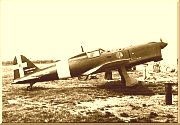Ambrosini SAI.207
| SAI.207 | |
|---|---|
 |
|
| Role | Light fighter |
| Manufacturer | Società Aeronautica Italiana / Ambrosini |
| Designer | Sergio Steffanuti |
| First flight | Spring 1941 |
| Primary user | Regia Aeronautica |
| Number built | 14 |
| Variants | Ambrosini SAI.403 |
The Ambrosini SAI.207 was a light fighter interceptor built entirely from wood and developed in Italy during World War II. Powered by a single 750 hp Isotta-Fraschini Delta, the SAI.207 enjoyed limited success during evaluation of the 12 pre-production aircraft.
The SAI.207 was developed from the Ambrosini SAI.7 racing and sporting monoplane after the light fighter concept had been proven with the Ambrosini SAI.107 prototype. Steffanuti designed the aircraft to have a lightweight structure and light armament to allow lower-powered engines to be used, without unduly reducing performance.
The first of three prototypes was completed and flown in the Autumn of 1940 as the sole SAI.107, which was a minimum change fighter development of the SAI.7, with identical dimensions, apart from length, at 8.02 m (26.31 ft) and the 402.7 kW (540 hp) Isotta-Fraschini Gamma engine. Weighing only 1,000 kg (2,205 lb) the Sai.107 reached a speed of 563 km/h (350 mph) in trials held at the Guidonia research establishment and manoeuvrability proved to be excellent. The SAI.107 was lost, along with pilot Arturo Ferrarin, in a crash on 18 July 1941.
Two more fighter prototypes were built as SAI.207s, flying for the first time in the spring of 1941 and 1942.
The SAI.207 was a single-seat, low-wing monoplane with a conventional tail-wheel undercarriage, developed from the Ambrosini SAI.7. Of wooden construction, giving a light structure, power was supplied by 559.3 kW (750 hp) Isotta-Fraschini Delta R.C.40 engine, cooling air entering the engine through a central intake. Armament consisted of two 12.7 mm (0.500 in) Breda-SAFAT machine guns.
In level flight the performance of this aircraft was impressive, achieving a speed of 580 km/h (360 mph) and over 800 km/h (497 mph) in a dive. The Ministero dell' Aeronautica soon placed a production order for 2,000 machines, plus a pre-production batch of 12 aircraft for operational testing. After the mixed results of operational evaluation and the signing of the Armistice, no production aircraft were built.
Flight testing revealed some major shortcomings, most of which were not rectified before the Armistice in 1943; the low power and high wing loading resulted in poor climb performance; the light structure prevented more powerful cannon from being used as the recoil forces overstressed the mounting structure; the rear cylinders of the engine overheated during recovery from a dive; the light structure also led to problems, with the second prototype wing exploding during a dive recovery due to internal pressure built up, caused by the lack of internal fairings in the undercarriage bays. The wooden structure was also badly affected by rain or humidity.
...
Wikipedia
